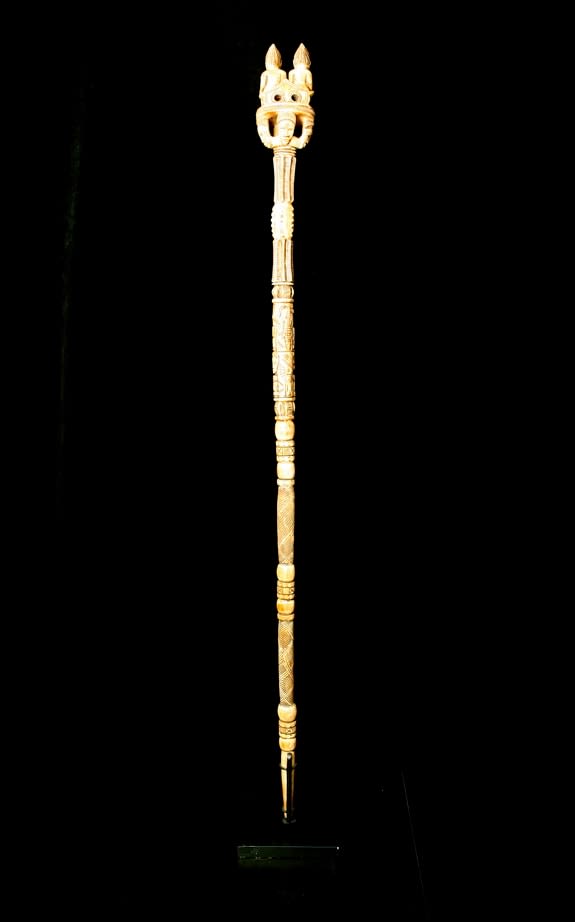Baule Ivory Sceptre, 1800 CE - 1900 CE
ivory
45.5
DE.068 (LSO)
This imposing ivory sceptre was made for a member of the ruling elite of the Baule, arguably the most important cultural group in the Ivory Coast area. It has a...
This imposing ivory sceptre was made for a member of the ruling elite of the Baule, arguably the most important cultural group in the Ivory Coast area. It has a plain bottom section, rising through a series of bands of cross-hatching, herringbone designs and geometrically-decorated rings. The upper aspect of the piece is decorated with figurative scenes, a combination of relief and incised anthropomorphic designs. Above this is a triple high-relief section, presumably for gripping while being used, with a highly elaborate staff head. This is formed of four female faces with ornate hair (or perhaps headwear) and facial scarifications, holding up a platform with a stool upon it, upon which are seated a chief with his wife and child. Both adults are naked except for prestige headwear; both have forehead scarring. The chief is holding an anthropomorphic sceptre in one hand and a short staff in the other, while his wife cradles her child on her lap.
The Baule live across the Ivory Coast area, and have an economy based primarily on sedentary agriculturism. They have thus been able to build up a considerable political and economic stronghold, which has in turn given rise to a strong ritual and artistic heritage. Their own creation story relates to an ancient migration, in which the queen was forced to sacrifice her son in order to ford a mighty river. So upset was she that all she could say was “baouli” (“the child is dead”), thus giving rise to the tribe’s name.
Blolo bian (male) and Blolo bla (female) spirit spouses are perhaps the Baule’s greatest artistic and psycho-social achievement. They are also known for sculptures representing bush spirits (Asie usu) – mischievous and potentially malevolent inhabitants of the “bush”, or dark country beyond the boundary of the village – monkeys, and three types of masks that are used in the celebration of good harvests, mourning, and the visits of important dignitaries. Secular items are also known, including heddle pulleys, doors, catapults and other utilitarian objects that are often decorated to a very high standard by Baule artists and craftsmen. Their metalworking – especially in gold – is also renowned for its quality. Their arts are most often confused with their neighbours, the Yaure and the Guro.
Like most other human societies, the Baule are prey to conspicuous consumption, which is a central key to asserting one’s status in the village, and thus one’s power and influence. While their carving is among the most refined and restrained in Africa, therefore, artists vie to produce more impressive and beautiful carvings which are often decorated or adorned by their proud owners. The current piece is an excellent example of this, for while canes and staffs are not uncommon in any African society, ivory is invariably associated with prestige and power structures. This is a rare and remarkable piece if African art.
The Baule live across the Ivory Coast area, and have an economy based primarily on sedentary agriculturism. They have thus been able to build up a considerable political and economic stronghold, which has in turn given rise to a strong ritual and artistic heritage. Their own creation story relates to an ancient migration, in which the queen was forced to sacrifice her son in order to ford a mighty river. So upset was she that all she could say was “baouli” (“the child is dead”), thus giving rise to the tribe’s name.
Blolo bian (male) and Blolo bla (female) spirit spouses are perhaps the Baule’s greatest artistic and psycho-social achievement. They are also known for sculptures representing bush spirits (Asie usu) – mischievous and potentially malevolent inhabitants of the “bush”, or dark country beyond the boundary of the village – monkeys, and three types of masks that are used in the celebration of good harvests, mourning, and the visits of important dignitaries. Secular items are also known, including heddle pulleys, doors, catapults and other utilitarian objects that are often decorated to a very high standard by Baule artists and craftsmen. Their metalworking – especially in gold – is also renowned for its quality. Their arts are most often confused with their neighbours, the Yaure and the Guro.
Like most other human societies, the Baule are prey to conspicuous consumption, which is a central key to asserting one’s status in the village, and thus one’s power and influence. While their carving is among the most refined and restrained in Africa, therefore, artists vie to produce more impressive and beautiful carvings which are often decorated or adorned by their proud owners. The current piece is an excellent example of this, for while canes and staffs are not uncommon in any African society, ivory is invariably associated with prestige and power structures. This is a rare and remarkable piece if African art.
